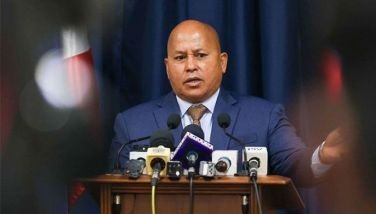Global economic crisis

For majority of the people staying home under the enhanced community quarantine measure it may feel like an extended spring or summer vacation. For the front liners, it is definitely an unimaginable, grueling and horrific experience. For the business world and the economy, the red flags are visible, the distress signal has been sounded off – it’s mayday.
The global growth was expected to rise from 2.9 percent in 2019 to 3.3 percent this year. The Gross Domestic Product (GDP) was estimated to be $87 trillion before the Covid-19 outbreak.
The promising outlook turned out to be a global disaster. The lockdown around the world has stopped majority of the economic activities. Business investments and financial loans are put to a halt, real estate at a standstill, personal consumptions except for basic commodities have lessened. Travel and leisure (airline, cruise lines and hotel/resort industries) have been heavily affected. In fact, almost 80% to 90% of their operations have temporarily stopped. The demand of oil and gas are very low. The over-all market faces very low demands. Economists are worried that we are headed toward a climate worse than the ‘Great Depression’.
The International Monetary Fund (IMF) chief economist, Gita Gopinath pegged the loss to the world economy at $9 trillion in 2020-21. The IMF foresees that “the coronavirus outbreak will drive a ‘Great Lockdown’ poised to be the worst recession in nearly a century.”
In his article entitled, Impact of the coronavirus pandemic on the global economy – Statistics & Facts, Erin Duffin, wrote: The economic damage caused by the COVID-19 pandemic is largely driven by a fall in demand, meaning that there are not consumers to purchase the goods and services available in the global economy. Duffin gave solutions that may ease the economy reiterating the importance of the support of central banks as the first line of defense.
He wrote, First, they have significantly eased monetary policy by cutting policy rates – in the case of advanced economies to historic lows. And half of the central banks in emerging markets and lower income countries have also cut policy rates. The effect of rare cuts will be reinforced through central bank’s guidance about the future path of monetary policy and expanded asset purchase programs. Second, central banks have provided additional liquidity to the financial system, including through open market operations. Third, a number of central banks have agreed to enhance the provision of US dollar liquidity through swap line arrangements. And finally, central banks have reactivated program used during the global financial crisis as well as launched a range of new broad-based programs, including to purchase riskier assets such as corporate bonds. By effectively stepping in as “buyer of last resort” in these markets and helping contain upward pressures on the cost of credit, central banks are ensuring that household and firms continue to have access to credit at an affordable price.
He further wrote, To date, central banks have announced plans to expand their provision of liquidity – including through loans and asset purchases – by at least $6 trillion and have indicated a readiness to do more if conditions warrant. As result of these actions aimed at containing the fallout from the pandemic, investor sentiment has stabilized in recent weeks. Strains in some markets have abated somewhat…Sentiment continues to be fragile, however, and global financial conditions remain much tighter compared to the beginning of the year.
In our country, desperate times call for desperate measures. First, the Senate called for the resignation of Secretary Duque (of the Department of Health) but the President told the Secretary to stay. When the National Economic and Development Authority Secretary Ernesto Pernia submitted his resignation on the eve of his very crucial COVID-19 economic stimulus package proposal, the President accepted it right away. What is happening? A man like Pernia is not one who would leave his work in the midst of a major crisis. This is not the Pernia I know. There must be something he planned to propose or do that the President did not like. And now, he is quickly replaced by a good-souled ‘kid’ Finance Undersecretary Karl Chua (one who is very close and important to Finance Secretary Sonny Dominguez) but seemingly a ‘foot-soldier’ of some sort. Abangan!
So, what is our government’s stimulus package during this COVID 19 crisis? A few days ago, the Philippine News Agency reported that a technical working group (TWG) of the House of Representatives’ Defeat Covid-19 Committee (DCC) will draft a consolidated bill proposing a P370-billion economic stimulus package to mitigate the impact of the coronavirus disease on the country’s economy.
Salceda’s Philippine National Stimulus Strategy proposes structural adjustment plans to increase the country’s economic resilience. This includes a Negative Interest Loans (NIL) plan, or a P350 billion loan package that will grant loans at negative interest in exchange for workers retention. The maximum loanable amount shall be 50 percent of the company’s direct labor costs and the loan shall be payable for three to five years.
* * *
To date, governments around the world have already committed to almost $7 trillion stimulus package. The US is expected to pass a $2 trillion stimulus package (which includes loans for small businesses, liquidity assistance and financial aid for hospitals). Australia has brought out three stimulus packages. The first one in early March, $11.4 billion for payments to small businesses to encourage hiring, one-time payment to people collecting government benefits such as old-age or veterans’ benefits, and business subsidies for industries such as tourism. The second, on March 22 worth $54.2 billion. The third on March 30, worth $79 billion.
The United Kingdom also gave out 3 stimulus packages. The first was a budget of nearly $37 billion in fiscal stimulus (includes a tax cut for retailers, cash grants to small businesses, a mandate to provide sick pay for people who need to self-isolate, a subsidy to cover the costs of sick pay for small businesses and expanded access to government benefits for the self-employed and unemployed). The second, on March 17 worth $379 billion in business loan guarantees, $23 billion in business tax cuts and grant funding to businesses hit worst by the virus, such as retail and hotel businesses. The third, on March 20 the UK government announced fiscal measures including a program to issue grants to companies covering up to 80% of worker’s salaries if companies keep them on payrolls rather than lay them off.
India announced a $22.5 billion spending plan to help the nation’s poor. It includes free grain subsidies and other staples for poor families for three months, expanded insurance for health care workers, a one-time cash payment to 30 million senior citizens, front-loading cash payments to 87 million farmers as part of an existing program, free cooking gas to women in rural areas for three months, and establishing a fund to help construction workers effected by the quarantine.
France announced a $49 billion aid package. Italy announced a $28 billion plan. Japan passed a package of small business loans, one $4.6 billion package in February and on March 11 another $15 billion. South Korea announced a $9.8 billion stimulus package.
The Canadian government announced $7.1 billion in loans to businesses. Russia announced a $4 billion fund. Brazil announced $30 billion in fiscal stimulus. And, so on and so forth.
We may have a good national plan but its not clear to the Filipinos. We need to hear it out loud and clear. Stop all the gibbering and blabbering. Go straight to the point.
- Latest
- Trending
































